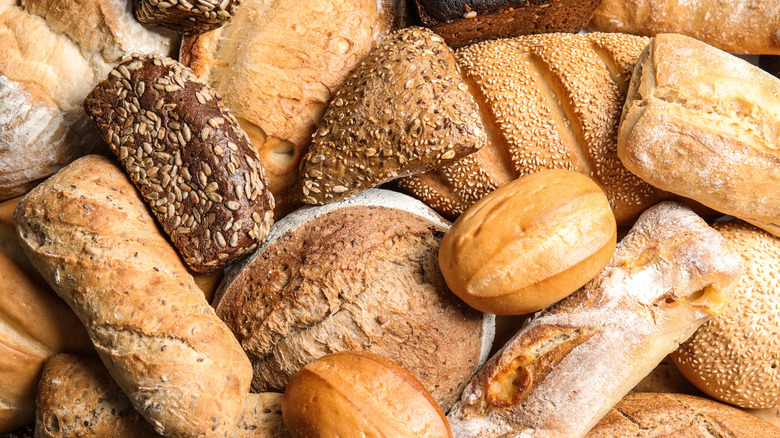How To Pick A Smart Kitchen Space To Store Fresh Bread
Like so many of the best things in life, great bread is fleeting, going stale in only a day or two. You might think this is just a result of the bread getting dry, but there's complex chemistry at play that makes stale bread more challenging to deal with.
According to Insider, the initial texture of fresh bread — soft and moist — is the result of a process called gelatinization. The hot oven weakens the attraction between the molecules in wheat starch, allowing it to absorb a great amount of water, much like a sponge. When bread goes stale, the water escapes the crumb of the bread, moving to the crust. This causes the starch molecules to return to their original state — hard and dense — just like they were in raw flour.
It's a problem that has plagued bakers since the first bread was made, and people have come up with many solutions over the years. These days, a lot of commercial bread is made using natural or artificial preservatives. Gold Medal Bakery explains that emulsifiers, such as mono-glycerides and soy lecithin, help the dough retain moisture, while enzymes including alpha-amylase make it fluffier to begin with. Such products can be a turn-off to some consumers, which is why you might prefer artisan loaves or homemade bread. However, these tend to go stale and spoil rapidly, unless you know the right place to store them.
For short-term storage, find a cool, dry place
Before you pick a place to store your bread, you should consider a few factors. First of all, what kind of bread are you storing? MasterClass notes that sourdough bread, dense rye, and seeded breads all have fairly long shelf lives, as will any loaf made with preservatives. Then, consider the climate you live in. If it's humid where you are, the bread will develop mold much faster. The best way to stave off mold and staling is to keep the bread in a paper bag or linen wrap and place it in a cool, dry place.
Food & Wine cautions against storing your bread near kitchen appliances that give off heat, such as the oven, refrigerator, or dishwasher, as these will hasten the growth of mold. Instead, store it in a cupboard or drawer.
You might also consider investing in a bread box, which is designed not to be airtight. Per Epicurious, this allows just enough moisture in the environment to keep the crumb soft while permitting air to circulate, holding off mold. Bread can last up to a week in a bread box, so they're a great option for short-term storage. However, if you don't plan to eat the whole loaf within a week, you'll need a long-term solution.
For long-term storage, use the freezer, never the fridge
Many people think of the refrigerator as the best place to store fresh food, but it's actually the worst possible place to store bread. The Los Angeles Times reports that a group of Spanish scientists analyzed the rate at which bread goes stale at different temperatures. They found that a moderately cold environment, around 40 F, caused the most rapid staling. Unfortunately, this is also the base temperature for a majority of household refrigerators, meaning that your bread will have the least amount of shelf life if you put it in the fridge.
Now, here's the part where things get weird. While moderate cold is terrible for bread, extreme cold (i.e. below freezing) is ideal, greatly slowing the rate of staling and preventing mold growth. Per Epicurious, this makes your freezer the best place to store bread if you need it to last beyond a couple of days.
To freeze bread properly, place it in a freezer-safe bag (you could use plastic here, as humidity isn't a concern). Press as much air out as possible to prevent freezer burn, and you're ready to freeze. When it's time to reheat the bread, pop it in a 325-degree oven for 20-30 minutes, which will re-gelatinize the starch, making it the closest thing to fresh bread that you can get.


